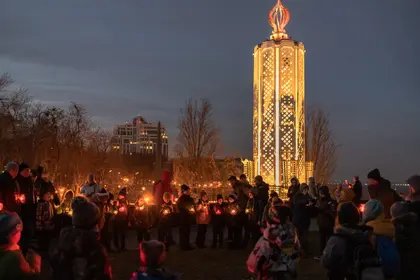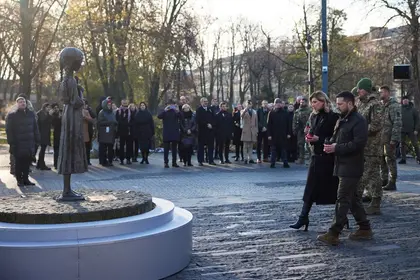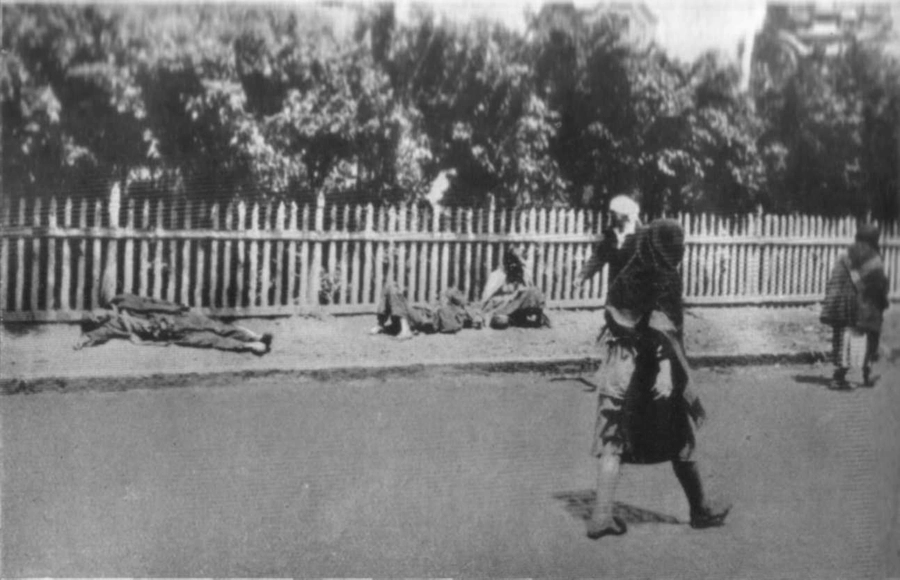In 1932-33, according to the latest, most conservative estimates, at least four million people were deliberately starved to death in Soviet-ruled Ukraine. This was due to Moscow’s imposition of excessive grain quotas and the forcible requisitioning of food from the villagers, accompanied by draconian, repressive measures. Ninety years later, and after almost two years since Russia launched a new genocidal war against Ukraine, the scale and significance of this unpunished crime is rightfully commanding more attention than ever.
Let’s briefly recall what occurred.
JOIN US ON TELEGRAM
Follow our coverage of the war on the @Kyivpost_official.
In 1932-33 the most fertile regions of the USSR were ravaged by the largest man-made famine in history. As part of his collectivization drive, Stalin unleashed mass terror against the peasantry and literally starved them into submission. Ukraine bore the brunt of the assault and the Ukrainian nation has suffered from the effects ever since. The traumatizing blow accompanied a purge of its national intelligentsia, and the intensification of Russification affected its demography and social composition, undermining its national assertiveness and severely stunting its national development.
Although impossible to give a precise total of the Ukrainians killed during the Holodomor, it is certainly no less than four million, and probably much higher.
Stalin had strongly advocated dispensing with the legal fiction of independence for the non-Russian republics in a nominally federated Union of Soviet Socialist Republics but was overruled by Lenin. After Lenin’s death, he declared in 1925: “The peasant question is the basis, the quintessence, of the national question. That explains the fact that the peasantry constitutes the main army of the national movement.” The following year, 1926, Stalin intervened against what he described as “a struggle for the alienation of Ukrainian cultural and social life from the Soviet cultural life, of a struggle against Moscow and Russians in general, against Russian culture.”

Science, Socialism, and Holodomor – Lessons Not to be Ignored
In 1928 Stalin launched his drive to collectivize agriculture, which inevitably targeted the most productive agricultural areas in Ukraine and the North Caucasus. In fact, his industrialization program was based on the forcible extraction of sufficient marketable grain from the peasants. Agricultural surpluses were to be exported in exchange for imported machinery.
The campaign was conducted in a ruthless manner, with total disregard for the suffering and human cost involved. Wealthier peasants, dubbed “kulaks,” and their families were rounded up and deported to remote regions – tens of thousands of them.
Peasant resistance was stiff particularly in Ukraine and among the nomadic herdsmen of Kazakhstan.
Ukrainians singled out
By 1932 the collectivization drive was virtually completed and the war to subdue the peasantry effectively won. Yet the assault on Ukraine continued. For here, because of the national question, it assumed an additional dimension.
Stalin, who viewed the nationalities question as being inherently linked with the peasantry, had made no secret of his disapproval of the national assertiveness of the Ukrainians. As the threat of famine loomed, pleas from Ukrainian Party officials to stop the continued grain seizures were received with irritation in Moscow, and more and more functionaries were dispatched from Moscow to Ukraine to ensure that Stalin’s policy was implemented.
Stalin wrote on Aug. 11 to his chief henchman in Ukraine, Lazar Kaganovich: “If we don’t make an effort now to improve the situation in Ukraine, we may lose Ukraine… Keep in mind that the Ukrainian Communist party includes not a few (yes, not a few!) rotten elements, conscious and non-conscious” nationalist and Polish agents. “I repeat – we can lose Ukraine.”
From November 1932 Ukrainian villages were economically blockaded if they failed to meet their quota. By the end of the year special “tow brigades” had seized all the available food and seed. Widespread hunger in one of Europe’s most productive agricultural regions began to turn into a famine of massive proportions. The parallel campaign against Ukrainian nationalism and “national deviationism” among Ukrainian Communists was intensified and linked even more directly with the struggle for grain.
In December 1932, Stalin again urged that Ukrainian nationalism be eradicated by intensified repression. As millions of Ukraine’s inhabitants starved to death, the Soviet Union continued exporting grain. The artificial terror famine raged in Soviet Ukraine and the North Caucasus, which was heavily populated by Ukrainians and where Ukrainian national schools and cultural facilities had been established. It did not spread to neighboring Belarus, or other parts of Russia.
The Soviet authorities did their best to conceal the facts and ensured that there were few foreign witnesses. Illustrious apologists for Soviet Communism, such as playwright George Bernard Shaw, Sidney and Beatrice Webb of the Fabian Society, and the Moscow correspondent of the New York Times, Walter Duranty, insisted reports of starvation were false or exaggerated.
In 1941, the Nazi invasion of the USSR turned Stalin – Hitler’s accomplice by virtue of the 1939 Molotov-Ribbentrop Pact, which involved a mutual non-aggression pact and the division of Eastern Europe – into an ally of the West; therefore concern about the means that “Uncle Joe” had used until then to consolidate his totalitarian rule was deferred or forgotten. Later, when his successor Nikita Khrushchev denounced Stalin at the 20th Congress of the Communist Party in 1956, he avoided discussing the period of forced collectivization and what followed, and the archives remained off-limits.
Revealing the hidden truth
In the West, Ukrainian émigrés who continued to attempt to draw attention to what had occurred in their homeland under Soviet rule were all too often dismissed as fanatical anti-Communists with an axe to grind. It was not until around the 50th anniversary of the famine – after intensified efforts to publicize the atrocity by Ukrainian scholars in North America, with Western scholars like Robert Conquest and James Mace delving more deeply into the subject – that it began to receive broader attention.
The Soviet authorities sought to undermine the validity of the research and publications that ensued by branding them as “anti-Soviet propaganda.” Almost right up to the very end of the Soviet era, they denied that the man-made famine in Ukraine had occurred and that millions had perished.
Stalin again urged that Ukrainian nationalism be eradicated by intensified repression. As millions of Ukraine’s inhabitants starved to death, the Soviet Union nevertheless continued exporting grain. The artificial terror famine raged in Soviet Ukraine and the North Caucasus, which was heavily populated by Ukrainians and where Ukrainian national schools and cultural facilities had been established. It did not spread to neighboring Belarus, or other parts of Russia.
Only after Ukraine achieved its independence could historians begin to discover what was left in the hitherto secret state archives and to publish their findings.
Yet, when glasnost finally began to make itself felt in Ukraine in the wake of the 1986 Chornobyl nuclear disaster, one of the first “blank spots” which the Ukrainian cultural intelligentsia began to demand be removed concerned this tragedy in the nations’ history. They were further encouraged when, in 1988, a Committee of the US Congress acknowledged the famine in Ukraine as an act of genocide.
Finally, in February 1990 the Communist Party of Ukraine reluctantly acknowledged in the face of mounting public pressure that the famine had taken place and was the result “of the criminal course pursued by Stalin and his closest entourage toward the peasantry.”
Only after Ukraine achieved its independence could historians begin to discover what was left in the hitherto secret state archives and to publish their findings. Consequently, during the 1990s much valuable material appeared confirming both the scale of the atrocity, but also, the way in which was organized.
As a result, the details of the man-made famine, or Holodomor as it has become known in Ukrainian (literally, killing by starvation), have become better and more firmly established as a defining experience in Ukrainian national consciousness. Their appearance also led Western scholars and public figures to examine what happened.
International recognition
Ukrainian scholarly and official efforts to have the Holodomor recognized as genocide achieved an important breakthrough in 2003, on the 70th anniversary of the Holodomor. The Ukrainian parliament, or Verkhovna Rada, recognized it as an act of genocide.
In October of that year, the first European scholarly forum on this topic was held in Vicenza under the auspices of the President of Italy and the Ukrainian Embassy in Rome. The participants included specialists from Western Europe, Ukraine, Russia, Poland and Canada. A leading contemporary Ukrainian scholar on the famine, Stanislav Kulchytsky, told the Ukrainian press that at the Vicenza symposium “the issue of the Holodomor as an act of genocide dominated the reports…”
A month later, at the 58th General Assembly of the United Nations, Ukraine’s efforts to obtain international recognition of the Holodomor as genocide achieved a preliminary partial success. Delegations from 20 countries, including Italy signing on behalf of the European Union and associated members, agreed to recognize it as a tragedy caused by the actions of a totalitarian regime.
During 2003, resolutions, or declarations, concerning the Holodomor were adopted by the US Congress, the Australian and Argentinian Senates and the Canadian and Hungarian parliaments.
After the democratic Orange Revolution in Ukraine at the end of 2004 and beginning of 2005, the new president of Ukraine, Viktor Yushchenko, stepped up efforts to get the UN to recognize the Holodomor as an act of genocide. He referred to it as such in his speech before the UN General Assembly on Sept. 15, 2005, and designated the fourth Saturday of November as an annual day of remembrance of the victims of the Holodomor and political repression.
After their analogous democratic revolutions brought their countries politically closer, Georgia extended support to Ukraine in this regard: at the beginning of 2006, the Georgian parliament formally acknowledged the Ukrainian famine as an act of genocide.
But in Russia, not only its political leadership but also many historians, political scientists and legal specialists opposed viewing the Holodomor as a genocide of the Ukrainians.
To this day no precise figures about the numbers of those who perished as a result of the Soviet collectivization drive and the Holodomor are available. Various Western scholars in the 1980s concluded that around five million died as a result of the general Soviet collectivization drive between 1929 and 1932. But this still leaves the question of how many victims the Holodomor claimed.
In an exclusive interview given to Kyiv Post this week, Director of the National Museum of the Holodomor, Lesia Hasydzhak, acknowledged that it remains impossible to give a precise total of the Ukrainians killed during the Holodomor, but it is certainly no less than four million, and probably much higher.
As of today, according to a survey conducted by the Sociological Rating Group in Ukraine, 92 percent of those polled agreed with the statement that “the Holodomor of 1932-1933 was a genocide of the Ukrainian people,” representing an increase of one and a half times compared to 2010. Twenty-eight countries have recognized the Holodomor as a genocide, and this month the Ukraine-initiated Declaration commemorating the 90th anniversary of Holodomor at the UN was signed by 55 UN Member States and the EU delegation.
Finally, 90 years later, the Holodomor has been recognized as the genocide it in fact was. Today, the challenge is to get the world to acknowledge that Russia’s war against Ukraine is once again a genocide conducted by an imperialist aggressor in a cynical and barbaric manner.
You can also highlight the text and press Ctrl + Enter







